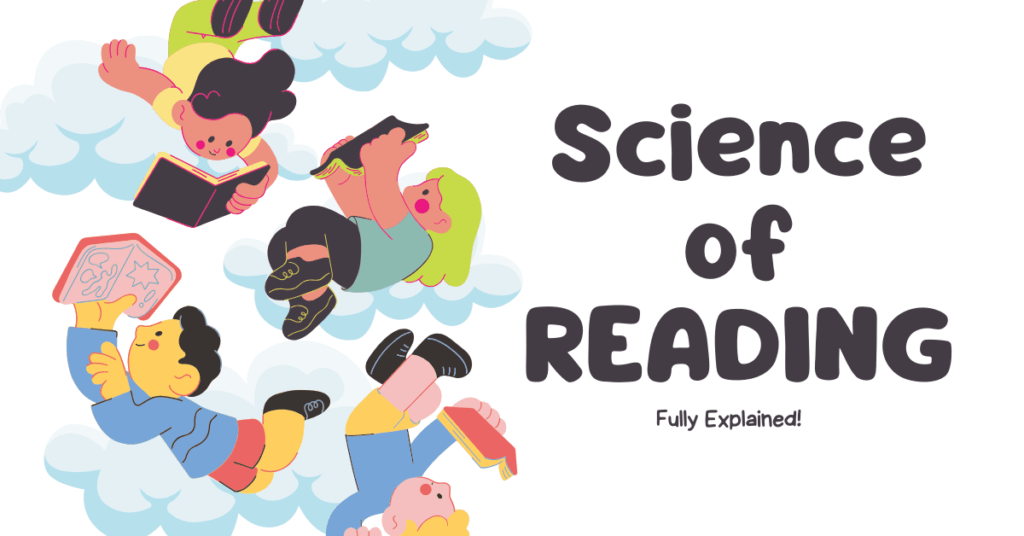Introduction
Have you ever wondered why some children effortlessly dive into books while others struggle to decode simple words? The answer lies in the fascinating realm of the science of reading. This groundbreaking field is revolutionizing our understanding of how the human brain learns to read and transforming the way we teach this essential skill.
Imagine a world where every child could unlock the magic of literacy with ease. 🔓📚 The science of reading holds the key to making this vision a reality. By delving into the intricate processes that occur in our brains when we read, researchers are uncovering powerful insights that can help educators, parents, and learners alike. From understanding the critical components of the reading process to exploring cutting-edge neuroscience findings, this blog post will take you on an enlightening journey through the landscape of literacy acquisition.
As we embark on this exploration, we’ll uncover the secrets behind evidence-based reading instruction, tackle common reading difficulties, and examine how technology is shaping the future of reading education. Get ready to discover how the science of reading is paving the way for more effective teaching methods and brighter futures for readers of all ages.

Understanding the Science of Reading
A. Definition and core principles
The Science of Reading is a comprehensive, evidence-based approach to understanding how humans learn to read and the most effective methods for teaching reading. At its core, this field combines insights from cognitive psychology, neuroscience, and education research to provide a holistic view of the reading process.
Key principles of the Science of Reading include:
- Phonological awareness
- Phonics instruction
- Fluency
- Vocabulary development
- Reading comprehension
Let’s explore these principles in more detail:
| Principle | Description | Importance |
| Phonological awareness | The ability to recognize and manipulate sounds in spoken language | Foundation for learning to read |
| Phonics instruction | Teaching the relationship between letters and sounds | Essential for decoding words |
| Fluency | The ability to read with speed, accuracy, and proper expression | Bridges decoding and comprehension |
| Vocabulary development | Building a robust understanding of words and their meanings | Crucial for comprehension and expression |
| Reading comprehension | The ability to understand and interpret written text | Ultimate goal of reading instruction |
B. Historical development of reading theories
The field of reading research has evolved significantly over the past century. Key milestones include:
- Early 20th century: Emphasis on whole-word recognition
- 1950s-1960s: Introduction of phonics-based approaches
- 1970s-1980s: Rise of whole language movement
- 1990s-2000s: Balanced literacy approach
- 2000s-present: Evidence-based Science of Reading
This evolution reflects a growing understanding of the complex cognitive processes involved in reading and the need for comprehensive, research-backed instructional methods.
C. Importance in education and cognitive development
The Science of Reading plays a crucial role in shaping educational practices and supporting cognitive development. Its importance is evident in several areas:
- Effective literacy instruction: By providing evidence-based strategies, the Science of Reading helps educators design more effective reading programs.
- Early intervention: Understanding the reading process allows for early identification of reading difficulties and targeted interventions.
- Cognitive skills development: Reading proficiency contributes to the development of critical thinking, problem-solving, and analytical skills.
- Academic success: Strong reading skills are foundational for success across all academic subjects.
- Lifelong learning: Proficient readers are better equipped to engage in self-directed learning throughout their lives.
By applying the principles of the Science of Reading, educators can create more inclusive and effective learning environments that support all students in developing strong literacy skills. This approach not only enhances academic performance but also contributes to overall cognitive development and lifelong learning capabilities.

Key Components of the Reading Process
Phonemic Awareness
Phonemic awareness is the foundation of reading development. It refers to the ability to identify and manipulate individual sounds (phonemes) in spoken words. This skill is crucial for understanding the relationship between letters and sounds, which is essential for reading and spelling.
Key aspects of phonemic awareness include:
- Identifying individual sounds in words
- Blending sounds to form words
- Segmenting words into individual sounds
- Manipulating sounds by adding, deleting, or substituting them
Studies have shown that children with strong phonemic awareness skills are more likely to become proficient readers. Here’s a comparison of phonemic awareness activities for different age groups:
| Age Group | Phonemic Awareness Activities |
| Preschool | Rhyming games, sound matching |
| Early Elementary | Sound blending, sound segmentation |
| Upper Elementary | Phoneme manipulation, word analysis |
Phonics
Phonics is the systematic approach to teaching the relationship between letters and sounds. It builds upon phonemic awareness by connecting spoken language to written text. Effective phonics instruction enables readers to decode unfamiliar words and develop reading fluency.
Key elements of phonics instruction include:
- Letter-sound correspondence
- Blending sounds to read words
- Segmenting words to spell
- Recognizing common spelling patterns
Fluency
Reading fluency is the ability to read text accurately, quickly, and with appropriate expression. It serves as a bridge between word recognition and comprehension. Fluent readers can focus on understanding the meaning of the text rather than decoding individual words.
Strategies to improve fluency include:
- Repeated reading of familiar texts
- Guided oral reading with feedback
- Partner reading
- Timed reading exercises
Vocabulary
Vocabulary knowledge is crucial for reading comprehension and overall language proficiency. A rich vocabulary allows readers to understand a wide range of texts and express themselves effectively.
Effective vocabulary instruction involves:
- Direct teaching of new words
- Contextual learning through reading
- Word-learning strategies (e.g., using context clues, analyzing word parts)
- Exposure to a variety of texts across different genres
Comprehension
Reading comprehension is the ultimate goal of reading instruction. It involves understanding, interpreting, and making connections with the text. Comprehension skills enable readers to extract meaning, analyze information, and apply knowledge gained from reading.
Key comprehension strategies include:
- Activating prior knowledge
- Predicting and questioning
- Visualizing and creating mental images
- Summarizing and synthesizing information
- Monitoring understanding and clarifying confusion
By focusing on these five key components of the reading process, educators can provide a comprehensive approach to reading instruction. This approach, grounded in the science of reading, ensures that learners develop the necessary skills to become proficient readers. As we move forward, we’ll explore how neuroscience contributes to our understanding of the reading process and informs effective teaching practices.

Neuroscience and Reading
Brain regions involved in reading
The science of reading has been significantly enhanced by neuroscience research, which has identified several key brain regions involved in the reading process. Understanding these regions helps educators and researchers develop more effective reading instruction methods.
Primary Brain Areas for Reading
| Brain Region | Function in Reading |
| Broca’s Area | Speech production and language processing |
| Wernicke’s Area | Language comprehension and word meaning |
| Visual Word Form Area | Recognition of written words |
| Angular Gyrus | Integration of information from different sensory modalities |
These regions work together in a complex network to enable fluent reading. The Visual Word Form Area, located in the left fusiform gyrus, is particularly crucial as it specializes in recognizing the visual form of words.
Neuroplasticity and learning to read
Neuroplasticity, the brain’s ability to form new neural connections and reorganize existing ones, plays a vital role in learning to read. This process is especially important during early childhood when the brain is highly malleable.
Key aspects of neuroplasticity in reading:
- Formation of reading circuits: As children learn to read, their brains develop specialized neural pathways for processing written language.
- Strengthening connections: Repeated exposure to words and reading practice reinforces these neural pathways.
- Adapting to different writing systems: The brain’s plasticity allows it to adapt to various orthographies, from alphabetic to logographic systems.
Understanding neuroplasticity has significant implications for reading instruction, emphasizing the importance of early, consistent, and structured reading experiences to optimize brain development for reading proficiency.
Differences between skilled and struggling readers
Neuroscience has revealed distinct differences in brain activation patterns between skilled and struggling readers, providing valuable insights for targeted interventions.
Skilled Readers
- Efficient activation: Show balanced activation across left hemisphere reading areas
- Rapid processing: Quickly recognize words and access their meanings
- Automaticity: Demonstrate automatic word recognition, freeing cognitive resources for comprehension
Struggling Readers
- Overactivation: Often show increased activation in right hemisphere areas, compensating for left hemisphere difficulties
- Slower processing: Take longer to recognize words and access their meanings
- Lack of automaticity: Require more conscious effort for word recognition, leaving fewer resources for comprehension
These neurological differences underscore the importance of evidence-based reading instruction tailored to individual needs. By understanding these variations, educators can develop targeted strategies to support struggling readers and help them develop more efficient neural pathways for reading.
As we delve deeper into the science of reading, it becomes clear that neuroscience provides a crucial foundation for understanding how we read and how to teach reading effectively. This knowledge informs evidence-based reading instruction methods, which we’ll explore in the next section.

Evidence-Based Reading Instruction
Structured literacy approach
The structured literacy approach forms the backbone of evidence-based reading instruction. This comprehensive method integrates various components of language and literacy, ensuring a systematic and explicit teaching process. Here’s a breakdown of the key elements:
| Component | Description | Example |
| Phonology | Study of sound structure in language | Rhyming, syllable segmentation |
| Phonics | Relationship between sounds and letters | Teaching ‘sh’ sound in ‘ship’ |
| Fluency | Ability to read with speed, accuracy, and expression | Repeated reading exercises |
| Vocabulary | Understanding and use of words | Word mapping activities |
| Comprehension | Making meaning from text | Asking and answering questions about a passage |
| Writing | Expressing ideas through written language | Sentence construction exercises |
By incorporating these elements, the structured literacy approach provides a solid foundation for reading success, especially beneficial for struggling readers and those with dyslexia.
Multisensory teaching methods
Multisensory teaching methods engage multiple senses simultaneously, enhancing the learning experience and improving retention. These methods are particularly effective in reading instruction as they cater to diverse learning styles. Some popular multisensory techniques include:
- Visual: Using color-coding for different phonemes or word parts
- Auditory: Incorporating songs or rhymes to reinforce phonics rules
- Kinesthetic: Tracing letters in sand or shaping them with playdough
- Tactile: Using textured letters for hands-on exploration
By combining these sensory experiences, students can form stronger neural connections, leading to improved reading skills and long-term retention of information.
Explicit and systematic instruction
Explicit and systematic instruction is a cornerstone of effective reading education. This approach involves:
- Clear and direct teaching of reading concepts
- Breaking down complex skills into manageable steps
- Following a logical sequence of instruction
- Providing ample opportunities for practice and feedback
For example, when teaching phonics, an educator might start with simple consonant-vowel-consonant words before progressing to more complex phonetic patterns. This methodical approach ensures that students have a solid grasp of foundational skills before moving on to more advanced concepts.
Assessment and progress monitoring
Regular assessment and progress monitoring are crucial components of evidence-based reading instruction. These practices allow educators to:
- Identify students’ strengths and weaknesses
- Tailor instruction to individual needs
- Track progress over time
- Make data-driven decisions about intervention strategies
Various assessment tools can be employed, such as:
- Standardized reading tests
- Curriculum-based measurements
- Informal reading inventories
- Digital reading assessment platforms
By consistently monitoring student progress, teachers can quickly identify and address any reading difficulties, ensuring that all students receive the support they need to become proficient readers.
With these evidence-based practices in place, educators can effectively guide students through the reading process, laying a strong foundation for literacy development. Next, we’ll explore how to address specific reading difficulties that some students may encounter.

Addressing Reading Difficulties
A. Common reading disorders
Reading disorders can significantly impact a person’s ability to learn and process written information. Here are some of the most common reading disorders:
- Dyslexia
- Visual Processing Disorder
- Auditory Processing Disorder
- Attention Deficit Hyperactivity Disorder (ADHD)
| Reading Disorder | Key Characteristics | Prevalence |
| Dyslexia | Difficulty with phonological processing, word recognition, and fluency | 5-10% of the population |
| Visual Processing Disorder | Trouble interpreting visual information | 2-3% of children |
| Auditory Processing Disorder | Difficulty processing and distinguishing sounds | 3-5% of children |
| ADHD | Challenges with focus, attention, and impulse control | 5-11% of children |
B. Early identification and intervention
Early identification of reading difficulties is crucial for effective intervention. Some key strategies include:
- Regular screenings in early childhood and elementary education
- Observing developmental milestones related to language and literacy
- Implementing standardized assessments to identify specific areas of difficulty
- Collaborating with parents, teachers, and specialists to gather comprehensive information
Early intervention programs should focus on:
- Phonological awareness training
- Structured literacy instruction
- Multisensory learning approaches
- Individualized support and accommodations
C. Tailored strategies for diverse learners
Addressing reading difficulties requires a personalized approach that caters to each learner’s unique needs. Here are some effective strategies:
- Explicit phonics instruction: Teach the relationship between letters and sounds systematically.
- Fluency practice: Use repeated readings, choral reading, and partner reading to improve reading speed and accuracy.
- Vocabulary development: Incorporate word study, context clues, and semantic mapping to enhance vocabulary knowledge.
- Comprehension strategies: Teach techniques like summarizing, questioning, and visualizing to improve understanding.
- Assistive technology: Utilize text-to-speech software, audiobooks, and reading apps to support struggling readers.
To accommodate diverse learners, consider the following approaches:
- Differentiated instruction: Adjust teaching methods, materials, and pacing to meet individual needs.
- Multi-modal learning: Incorporate visual, auditory, and kinesthetic elements in lessons.
- Scaffolded instruction: Provide gradually decreasing levels of support as learners become more proficient.
- Collaborative learning: Encourage peer support and group activities to foster engagement and motivation.
By implementing these tailored strategies and interventions, educators and parents can help struggling readers overcome their difficulties and develop strong literacy skills. As we move forward, it’s essential to consider how technology can further support and enhance the science of reading in addressing these challenges.

Technology and the Science of Reading | Science of Reading
Digital tools for reading instruction | Science of Reading
In recent years, technology has revolutionized the way we approach reading instruction, offering innovative solutions that align with the science of reading. Digital tools have become invaluable resources for educators, parents, and learners alike, providing personalized and engaging experiences that enhance the reading process.
Here are some key digital tools that have transformed reading instruction:
- Interactive e-books
- Reading fluency apps
- Phonics games and activities
- Vocabulary building software
- Comprehension assessment tools
These digital tools offer several advantages over traditional methods:
| Advantage | Description |
| Engagement | Interactive elements capture and maintain learners’ attention |
| Personalization | Adaptive features cater to individual learning needs |
| Immediate feedback | Real-time assessments help track progress and identify areas for improvement |
| Accessibility | Digital platforms make learning materials available anytime, anywhere |
| Data-driven insights | Analytics help educators make informed decisions about instruction |
Adaptive learning platforms | Science of Reading
Adaptive learning platforms represent a significant advancement in reading instruction, leveraging the science of reading to provide tailored experiences for each learner. These platforms use sophisticated algorithms to analyze a student’s performance and adjust the difficulty and content of reading materials accordingly.
Key features of adaptive learning platforms include:
- Continuous assessment of reading skills
- Customized learning paths
- Targeted practice exercises
- Progress tracking and reporting
By adapting to each student’s unique needs and pace, these platforms ensure that learners are always working within their zone of proximal development, maximizing their potential for growth and mastery of reading skills.
AI-powered reading assistants | Science of Reading
Artificial Intelligence (AI) has ushered in a new era of reading support through AI-powered reading assistants. These advanced tools use natural language processing and machine learning to provide real-time assistance and guidance to readers of all levels.
Some noteworthy capabilities of AI reading assistants include:
- Text-to-speech functionality with natural-sounding voices
- Contextual vocabulary explanations
- Intelligent summarization of complex texts
- Pronunciation guides and feedback
- Reading comprehension question generation
AI reading assistants not only support struggling readers but also challenge advanced readers by offering deeper insights into texts and promoting critical thinking skills.
As we continue to explore the intersection of technology and the science of reading, it’s clear that these digital tools, adaptive platforms, and AI-powered assistants are reshaping the landscape of reading instruction. They offer unprecedented opportunities for personalized learning experiences that cater to diverse needs and learning styles. Moving forward, we’ll examine the future directions in reading research and how they might further enhance our understanding and application of the science of reading.

Future Directions in Reading Research | Science of Reading
Emerging trends in cognitive science | Science of Reading
As we delve into the future directions of reading research, it’s crucial to examine the emerging trends in cognitive science that are shaping our understanding of how we learn and process information. These advancements are paving the way for innovative approaches to reading instruction and literacy development.
One of the most promising trends is the integration of artificial intelligence (AI) and machine learning in cognitive research. These technologies are enabling scientists to analyze vast amounts of data on brain activity and reading behaviors, leading to more nuanced insights into the reading process. For instance, AI-powered eye-tracking studies are revealing intricate patterns in how we visually process text, which could inform the design of more effective reading materials.
Another significant trend is the growing focus on neuroplasticity and its implications for reading acquisition. Researchers are exploring how the brain’s ability to form new neural connections can be harnessed to enhance reading skills across all age groups. This has led to the development of targeted interventions that aim to rewire the brain’s reading circuits more efficiently.
| Trend | Potential Impact on Reading Research |
| AI and Machine Learning | Enhanced data analysis, personalized reading instruction |
| Neuroplasticity Studies | Targeted interventions, improved remediation techniques |
| Cross-disciplinary Approaches | Holistic understanding of reading processes |
| Emotional and Social Factors | Comprehensive strategies for engagement and motivation |
Potential breakthroughs in reading instruction | Science of Reading
Building on these cognitive science trends, several potential breakthroughs in reading instruction are on the horizon:
- Personalized reading programs: Advanced algorithms could analyze individual reading patterns and cognitive profiles to create tailored instruction plans.
- Virtual reality (VR) reading environments: Immersive VR experiences may help struggling readers by providing controlled, interactive learning spaces.
- Neurofeedback techniques: Real-time brain activity monitoring could guide readers to optimize their cognitive state for improved comprehension and retention.
- Multisensory reading tools: Leveraging multiple sensory inputs may enhance the reading experience and improve information processing for diverse learners.
These innovations have the potential to revolutionize how we approach reading instruction, making it more effective, engaging, and accessible to all learners.
Implications for lifelong learning and literacy | Science of Reading
The advancements in reading research and instruction have far-reaching implications for lifelong learning and literacy:
- Continuous skill development: As our understanding of the reading process evolves, individuals may be able to continually refine their reading skills throughout their lives.
- Bridging the literacy gap: Innovative instructional methods could help address disparities in reading abilities across different socioeconomic groups and age ranges.
- Enhanced cognitive flexibility: Improved reading skills may contribute to greater cognitive flexibility, benefiting various aspects of personal and professional life.
- Adaptive learning ecosystems: Future learning environments may dynamically adjust to individual needs, promoting sustained literacy growth.
As we look ahead, the intersection of cognitive science, technology, and reading research promises to unlock new possibilities for literacy development. By embracing these emerging trends and potential breakthroughs, we can work towards a future where effective reading instruction and lifelong learning opportunities are accessible to all. The journey towards universal literacy continues, driven by scientific inquiry and innovative approaches to understanding the complex process of reading.

Conclusion | Science of Reading
The science of reading has revolutionized our understanding of how humans acquire and develop literacy skills. By delving into the key components of the reading process, neuroscience insights, and evidence-based instructional methods, educators and researchers have paved the way for more effective teaching strategies. This comprehensive approach addresses reading difficulties, leverages technology, and continues to evolve as new research emerges.
As we look to the future of reading education, it’s clear that embracing the science of reading is crucial for fostering literacy in learners of all ages. By implementing evidence-based practices and staying informed about the latest research, we can create more inclusive and effective learning environments. Whether you’re an educator, parent, or lifelong learner, understanding the science of reading empowers you to support and enhance literacy development for yourself and others.
Check Out The Sources
Check Out More



